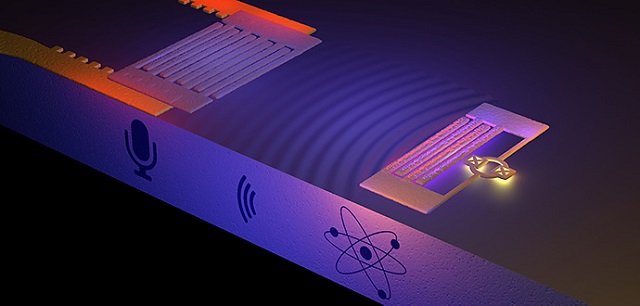 On the right, an artificial atom generates sound waves consisting of ripples on the surface of a solid. The sound, known as a surface acoustic wave (SAW) is picked up on the left by a "microphone" composed of interlaced metal fingers. According to theory, the sound consists of a stream of quantum particles, the weakest whisper physically possible. The illustration is not to scale. Credit: Philip Krantz, Krantz NanoArt.
On the right, an artificial atom generates sound waves consisting of ripples on the surface of a solid. The sound, known as a surface acoustic wave (SAW) is picked up on the left by a "microphone" composed of interlaced metal fingers. According to theory, the sound consists of a stream of quantum particles, the weakest whisper physically possible. The illustration is not to scale. Credit: Philip Krantz, Krantz NanoArt.
Chalmers researchers have demonstrated the possibility of communicating with an atom using sound. They have successfully coupled acoustic waves to an artificial atom.
The experiment’s research group leader, Per Delsing, states that by listening and talking to atoms, the research has opened significant prospects in the quantum domain. The study’s objective was to exploit quantum physics and derive benefits from quantum laws. This may help build super fast computers and is done by making electrical circuits which obey quantum laws.
Artificial atoms are an example of quantum electrical circuits and just like regular atoms, they can be charged with energy, which is later emitted as particles.
Typically they are light particles; however, the Chalmers experiment particles emitted and absorbed sound as energy.
The first author of the paper, Martin Gustafsson, states that sound from atoms are split into quantum particles; these particles being the weakest sound to be detected.
Sound waves travel at a slower speed than light, and this property will enable control of quantum particles during travel. As sound has a slower speed, these waves have comparatively shorter wavelength. Atoms interacting with light waves are smaller than its wavelength, however the atom can be larger than the wavelength of sound, implying improved control of its properties.
The researchers chose a frequency of 4.8GHz, which is almost that of microwave frequencies. This shortened the wavelength of the sound to a level that could be guided on a microchip’s surface. The researchers placed a 0.01mm long artificial atom on the same microchip, forming a superconducting material.
Theoretical and experimental physicists have collaborated in this study which has been published in the journal Science.
References